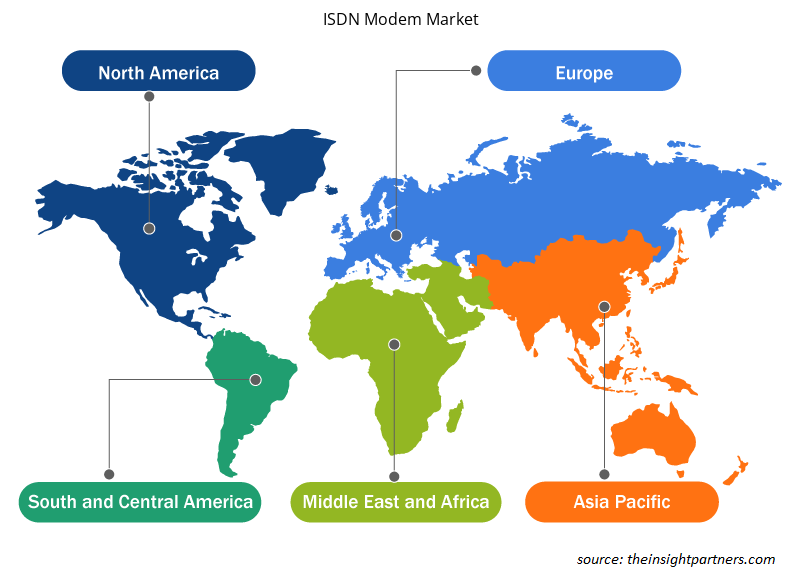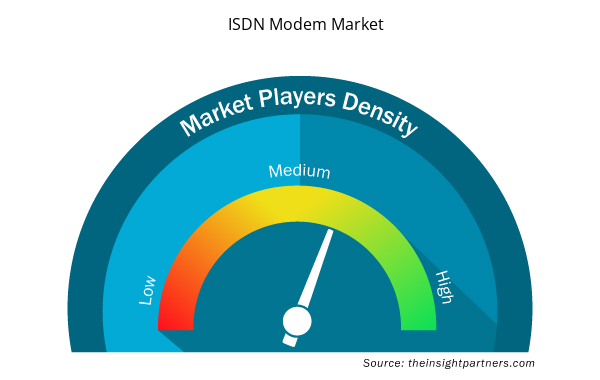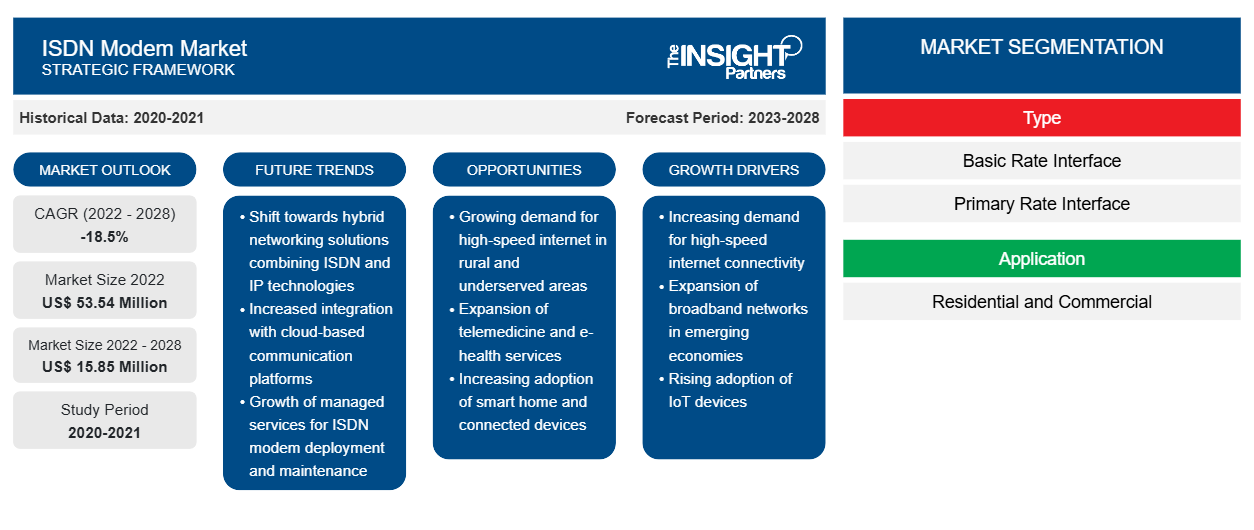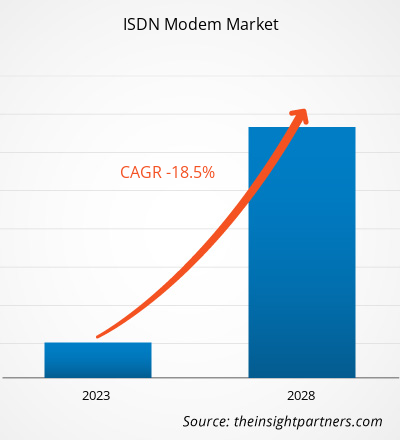Der ISDN-Modemmarkt dürfte von 53,54 Millionen US-Dollar im Jahr 2022 auf 15,85 Millionen US-Dollar im Jahr 2028 schrumpfen; für den Zeitraum von 2022 bis 2028 wird eine durchschnittliche jährliche Wachstumsrate (CAGR) von -18,5 % erwartet.
Die ISDN-Industrie begann in den 1980er Jahren bei Bell Labs und wurde 1988 zusammen mit ihren Standards kommerzialisiert. Die damals weltweit tätigen Unternehmen nutzten die ISDN-Leitungen für ihre Geschäftstätigkeit voll aus. Im Jahr 2000 begannen jedoch mehrere Länder, auf verbesserte Technologien umzusteigen, die ihnen höhere Internetgeschwindigkeiten und moderne Telekommunikationsbetriebe ermöglichten. So begannen beispielsweise Breitband-, Digital Subscriber Lines (DSL)-Router und Asymmetrical Digital Subscriber Lines (ADSL) die ISDN-Modemtechnologien in verschiedenen Regionen zu ersetzen.
ISDN-Modems sind weiter verbreitet als Digital Subscriber Line (DSL) und Kabelmodemtechnologien und werden in unterentwickelten Ländern immer noch als Backup-Leitung verwendet, wenn die Hauptleitung eines Netzwerks ausfällt. Sie werden häufig in privaten Anwendungen wie kleinen Heimbüros für zusätzliche Telefonleitungen und guten Sprachdienst verwendet. Darüber hinaus wurde das Wachstum des ISDN-Modemmarktes hauptsächlich durch mehrere Vorteile wie Hochgeschwindigkeitsdatenübertragung während Telefonkonferenzen vorangetrieben, um den wachsenden Bedarf an integrierter Geschäftskommunikation in kleinen Unternehmen zu unterstützen. Darüber hinaus haben die verschiedenen Funktionen des ISDN-Modems wie Anrufweiterleitung, Anruf halten und Anrufer-ID die Präferenz für ISDN-Modems als Backup-Leitung in mehreren Unternehmen erhöht.
Passen Sie diesen Bericht Ihren Anforderungen an
Sie erhalten kostenlose Anpassungen an jedem Bericht, einschließlich Teilen dieses Berichts oder einer Analyse auf Länderebene, eines Excel-Datenpakets sowie tolle Angebote und Rabatte für Start-ups und Universitäten.
- Holen Sie sich die wichtigsten Markttrends aus diesem Bericht.Dieses KOSTENLOSE Beispiel umfasst eine Datenanalyse von Markttrends bis hin zu Schätzungen und Prognosen.
Darüber hinaus ist in unterentwickelten Ländern wie Äthiopien die Einführung von ISDN-Modems als Backup-Leitung zu beobachten. So beschaffte beispielsweise Target Business Consultants Pvt. Ltd. Co., ein in Äthiopien ansässiges Unternehmen, im Juni 2021 in Zusammenarbeit mit der MasterCard Foundation etwa 8 ISDN-Modems für ein COVID-19-Projekt, das vom Ministerium für Innovation und Technologie (MInT) der Demokratischen Bundesrepublik Äthiopien durchgeführt wurde. Solche Fälle haben die Nachfrage nach ISDN-Modems in der gesamten afrikanischen Region angekurbelt.
Das Broadband Integrated Services Digital Network (B-ISDN) ist ein virtuelles leitungsvermitteltes Netzwerk, das High-Packet-Switching-Dienste und ein flexibles Format, d. h. den asynchronen Übertragungsmodus, zur Datenübertragung nutzen kann. B-ISDN, ein Hochgeschwindigkeits-Glasfasernetz, kann mit 100 Mbit/s betrieben werden, was ideal für Videoanwendungen ist, einschließlich Videoüberwachung und Videokonferenzen. Allerdings wird erwartet, dass die B-ISDN-Technologie bis 2025 eingestellt wird, was die derzeitige Größe des ISDN-Modemmarktes einschränken wird.
Auswirkungen der COVID-19-Pandemie auf den ISDN-Modemmarkt
Die COVID-19-Pandemie hatte schwerwiegende Auswirkungen auf verschiedene Branchen, von der Fertigung bis hin zu Fluggesellschaften. Die Technologiebranche weltweit hatte sie jedoch einen positiven Einfluss. Als Sicherheitsmaßnahme erzwangen Regierungen weltweit die Arbeit von zu Hause aus, um die Ausbreitung des COVID-19-Virus einzudämmen. Aufgrund dieser Regierungsmaßnahmen wurden viele Unternehmen unter Druck gesetzt, schnell auf Fernarbeit umzustellen. Im Rahmen dieser Maßnahme führten mehrere Unternehmen Webex, Microsoft Teams und verschiedene Kommunikationsmethoden wie Smartphones ein. Anstatt auf VOIP umzusteigen und bestehende Kommunikation zu ersetzen, entschieden sich die Unternehmen für die oben genannten Methoden. Dieser Faktor hat sich positiv auf die Größe des ISDN-Modemmarktes ausgewirkt, da viele Unternehmen darauf verzichtet haben, bestehende Systeme durch neue Systeme wie VoIP oder andere zusätzliche Dienste wie ISDN zu ersetzen. Darüber hinaus haben sich einige Länder mit schlechter Telekommunikationsinfrastruktur wie Äthiopien während der COVID-19-Pandemie ebenfalls für ISDN-Modems für Kampagnen in abgelegenen Gebieten entschieden. So hatte beispielsweise im Juli 2021 das Ministerium für Innovation und Technologie (MInT) der Demokratischen Bundesrepublik Äthiopien in Zusammenarbeit mit der MasterCard Foundation eine Ausschreibung für den Kauf von 8 ISDN-Modems für ihr jeweiliges COVID-19-Projekt in Äthiopien veröffentlicht. Solche Fälle haben den Markt im Geschäftsjahr 2020-2021 angetrieben.
Markteinblicke – ISDN-Modem-Markt
Basierend auf der Region ist die ISDN-Modemmarktanalyse hauptsächlich in Nordamerika, Europa, Asien-Pazifik, den Nahen Osten und Afrika sowie Südamerika unterteilt. Es wird erwartet, dass Nordamerika den Markt mit dem größten Marktanteil an ISDN-Modems im Jahr 2022 dominieren wird und seine Dominanz im Prognosezeitraum beibehalten wird, gefolgt von Europa und dem Asien-Pazifik-Raum. Darüber hinaus ist der ISDN-Modemmarkt im Asien-Pazifik-Raum auf die zunehmenden Exporte von ISDN-Terminals und -Adaptern aus Ländern wie Indien zurückzuführen. Darüber hinaus wird erwartet, dass Indien den regionalen Markt im Asien-Pazifik-Raum mit einem größeren Marktanteil an ISDN-Modems im Jahr 2022 dominieren wird.
Anwendungseinblicke – ISDN-Modemmarkt
Basierend auf der Anwendung wird die ISDN-Modemmarktanalyse in private und gewerbliche Anwendungen unterteilt. Das gewerbliche Segment wird voraussichtlich im Jahr 2022 den Markt dominieren. Außerdem wird erwartet, dass das Segment auch im Prognosezeitraum seine Dominanz behält. Das Wachstum des ISDN-Modemmarkts für das gewerbliche Segment ist hauptsächlich auf die Nachfrage nach ISDN-Modems bei Unternehmen in Ländern mit schlechter Telekommunikationsinfrastruktur wie Mexiko, Venezuela und den Niederlanden zurückzuführen. Mexikanische Unternehmen nutzen für ihre jeweiligen Geschäftstätigkeiten weiterhin ISDN-Netze, wobei die Nachfrage nach neuen ISDN-Modems von internationalen Akteuren auf dem ISDN-Modemmarkt wie den USA und Großbritannien gedeckt wird.
Regionale Einblicke in den ISDN-Modemmarkt
Die regionalen Trends und Faktoren, die den ISDN-Modemmarkt im Prognosezeitraum beeinflussen, wurden von den Analysten von Insight Partners ausführlich erläutert. In diesem Abschnitt werden auch ISDN-Modemmarktsegmente und -geografie in Nordamerika, Europa, im asiatisch-pazifischen Raum, im Nahen Osten und Afrika sowie in Süd- und Mittelamerika erörtert.

- Erhalten Sie regionale Daten zum ISDN-Modemmarkt
Umfang des ISDN-Modem-Marktberichts
| Berichtsattribut | Details |
|---|---|
| Marktgröße im Jahr 2022 | 53,54 Millionen US-Dollar |
| Marktgröße bis 2028 | 15,85 Millionen US-Dollar |
| Globale CAGR (2022 - 2028) | -18,5 % |
| Historische Daten | 2020-2021 |
| Prognosezeitraum | 2023–2028 |
| Abgedeckte Segmente | Nach Typ
|
| Abgedeckte Regionen und Länder | Nordamerika
|
| Marktführer und wichtige Unternehmensprofile |
|
Dichte der ISDN-Modem-Marktteilnehmer: Auswirkungen auf die Geschäftsdynamik verstehen
Der ISDN-Modemmarkt wächst rasant, angetrieben durch die steigende Nachfrage der Endnutzer aufgrund von Faktoren wie sich entwickelnden Verbraucherpräferenzen, technologischen Fortschritten und einem größeren Bewusstsein für die Vorteile des Produkts. Mit steigender Nachfrage erweitern Unternehmen ihr Angebot, entwickeln Innovationen, um die Bedürfnisse der Verbraucher zu erfüllen, und nutzen neue Trends, was das Marktwachstum weiter ankurbelt.
Die Marktteilnehmerdichte bezieht sich auf die Verteilung von Firmen oder Unternehmen, die in einem bestimmten Markt oder einer bestimmten Branche tätig sind. Sie gibt an, wie viele Wettbewerber (Marktteilnehmer) in einem bestimmten Marktraum im Verhältnis zu seiner Größe oder seinem gesamten Marktwert präsent sind.
Die wichtigsten auf dem ISDN-Modemmarkt tätigen Unternehmen sind:
- Ekinops
- TERRATEL
- Patton LLC
- Eine TLC Srl
- Epygi Technologies LLC
Haftungsausschluss : Die oben aufgeführten Unternehmen sind nicht in einer bestimmten Reihenfolge aufgeführt.

- Überblick über die wichtigsten Akteure auf dem ISDN-Modemmarkt
Epygi Technologies LLC, Polycom, Ekinops, Xiamen Yeastar Information Technology Co. Ltd. und HypermediaS gehören zu den führenden Akteuren auf dem ISDN-Modemmarkt weltweit. Der ISDN-Modemmarkt ist stark konsolidiert und verfügt über gut etablierte Marktteilnehmer und Marktführer.
Die Akteure auf dem ISDN-Modemmarkt konzentrieren sich hauptsächlich darauf, die Kunden in unterentwickelten Ländern zu bedienen, die noch immer mit der herkömmlichen ISDN-Infrastruktur arbeiten. Mehrere große Länder haben ihre bestehenden ISDN- und Public Safety Data Network (PSDN)-Leitungen für ihren jeweiligen Betrieb bereits durch Digital Subscriber Lines (DSL), Asymmetrical Digital Subscriber Line (ADSL), Wide Area Network (WAN) und Voice Over Internet Protocol (VoIP)-Systeme ersetzt. Darüber hinaus konzentrieren sich die bestehenden Akteure auf dem ISDN-Modemmarkt darauf, ihr Produktangebot zu verändern, um den Marktanforderungen gerecht zu werden und ihre Marktposition in ihren jeweiligen Branchen zu behaupten.
- Historische Analyse (2 Jahre), Basisjahr, Prognose (7 Jahre) mit CAGR
- PEST- und SWOT-Analyse
- Marktgröße Wert/Volumen – Global, Regional, Land
- Branche und Wettbewerbsumfeld
- Excel-Datensatz



Report Coverage
Revenue forecast, Company Analysis, Industry landscape, Growth factors, and Trends

Segment Covered
This text is related
to segments covered.

Regional Scope
North America, Europe, Asia Pacific, Middle East & Africa, South & Central America

Country Scope
This text is related
to country scope.
Häufig gestellte Fragen
Primary Rate Interface (PRI) segment is expected to hold a major market share of ISDN modem market in 2022
India, UK, and France are expected to register slow declining rate during the forecast period
The US is expected to hold a major market share of ISDN modem market in 2022
Asia Pacific is expected to decline at a slower rate in the ISDN modem market during the forecast period (2022-2028)
Deployment of B-ISDN systems
Epygi Technologies LLC, Polycom, Ekinops, Xiamen Yeastar Information Technology Co. Ltd., and HypermediaS are the key market players expected to hold a major market share of ISDN modem market in 2022
The global market size of ISDN modem market by 2028 will be around US$ 15.85 million
The estimated global market size for the ISDN modem market in 2022 is expected to be around US$ 53.54 million
Demand for Backup Line Across Underdeveloped Countries
Trends and growth analysis reports related to Electronics and Semiconductor : READ MORE..
The List of Companies - ISDN Modem Market
- Ekinops
- TERRATEL
- Patton LLC
- A TLC S.r.l.
- Epygi Technologies LLC
- Polycom
- Xiamen Yeastar Information Technology Co. Ltd.
- HypermediaS
- Aristel Networks
The Insight Partners performs research in 4 major stages: Data Collection & Secondary Research, Primary Research, Data Analysis and Data Triangulation & Final Review.
- Data Collection and Secondary Research:
As a market research and consulting firm operating from a decade, we have published and advised several client across the globe. First step for any study will start with an assessment of currently available data and insights from existing reports. Further, historical and current market information is collected from Investor Presentations, Annual Reports, SEC Filings, etc., and other information related to company’s performance and market positioning are gathered from Paid Databases (Factiva, Hoovers, and Reuters) and various other publications available in public domain.
Several associations trade associates, technical forums, institutes, societies and organization are accessed to gain technical as well as market related insights through their publications such as research papers, blogs and press releases related to the studies are referred to get cues about the market. Further, white papers, journals, magazines, and other news articles published in last 3 years are scrutinized and analyzed to understand the current market trends.
- Primary Research:
The primarily interview analysis comprise of data obtained from industry participants interview and answers to survey questions gathered by in-house primary team.
For primary research, interviews are conducted with industry experts/CEOs/Marketing Managers/VPs/Subject Matter Experts from both demand and supply side to get a 360-degree view of the market. The primary team conducts several interviews based on the complexity of the markets to understand the various market trends and dynamics which makes research more credible and precise.
A typical research interview fulfils the following functions:
- Provides first-hand information on the market size, market trends, growth trends, competitive landscape, and outlook
- Validates and strengthens in-house secondary research findings
- Develops the analysis team’s expertise and market understanding
Primary research involves email interactions and telephone interviews for each market, category, segment, and sub-segment across geographies. The participants who typically take part in such a process include, but are not limited to:
- Industry participants: VPs, business development managers, market intelligence managers and national sales managers
- Outside experts: Valuation experts, research analysts and key opinion leaders specializing in the electronics and semiconductor industry.
Below is the breakup of our primary respondents by company, designation, and region:

Once we receive the confirmation from primary research sources or primary respondents, we finalize the base year market estimation and forecast the data as per the macroeconomic and microeconomic factors assessed during data collection.
- Data Analysis:
Once data is validated through both secondary as well as primary respondents, we finalize the market estimations by hypothesis formulation and factor analysis at regional and country level.
- Macro-Economic Factor Analysis:
We analyse macroeconomic indicators such the gross domestic product (GDP), increase in the demand for goods and services across industries, technological advancement, regional economic growth, governmental policies, the influence of COVID-19, PEST analysis, and other aspects. This analysis aids in setting benchmarks for various nations/regions and approximating market splits. Additionally, the general trend of the aforementioned components aid in determining the market's development possibilities.
- Country Level Data:
Various factors that are especially aligned to the country are taken into account to determine the market size for a certain area and country, including the presence of vendors, such as headquarters and offices, the country's GDP, demand patterns, and industry growth. To comprehend the market dynamics for the nation, a number of growth variables, inhibitors, application areas, and current market trends are researched. The aforementioned elements aid in determining the country's overall market's growth potential.
- Company Profile:
The “Table of Contents” is formulated by listing and analyzing more than 25 - 30 companies operating in the market ecosystem across geographies. However, we profile only 10 companies as a standard practice in our syndicate reports. These 10 companies comprise leading, emerging, and regional players. Nonetheless, our analysis is not restricted to the 10 listed companies, we also analyze other companies present in the market to develop a holistic view and understand the prevailing trends. The “Company Profiles” section in the report covers key facts, business description, products & services, financial information, SWOT analysis, and key developments. The financial information presented is extracted from the annual reports and official documents of the publicly listed companies. Upon collecting the information for the sections of respective companies, we verify them via various primary sources and then compile the data in respective company profiles. The company level information helps us in deriving the base number as well as in forecasting the market size.
- Developing Base Number:
Aggregation of sales statistics (2020-2022) and macro-economic factor, and other secondary and primary research insights are utilized to arrive at base number and related market shares for 2022. The data gaps are identified in this step and relevant market data is analyzed, collected from paid primary interviews or databases. On finalizing the base year market size, forecasts are developed on the basis of macro-economic, industry and market growth factors and company level analysis.
- Data Triangulation and Final Review:
The market findings and base year market size calculations are validated from supply as well as demand side. Demand side validations are based on macro-economic factor analysis and benchmarks for respective regions and countries. In case of supply side validations, revenues of major companies are estimated (in case not available) based on industry benchmark, approximate number of employees, product portfolio, and primary interviews revenues are gathered. Further revenue from target product/service segment is assessed to avoid overshooting of market statistics. In case of heavy deviations between supply and demand side values, all thes steps are repeated to achieve synchronization.
We follow an iterative model, wherein we share our research findings with Subject Matter Experts (SME’s) and Key Opinion Leaders (KOLs) until consensus view of the market is not formulated – this model negates any drastic deviation in the opinions of experts. Only validated and universally acceptable research findings are quoted in our reports.
We have important check points that we use to validate our research findings – which we call – data triangulation, where we validate the information, we generate from secondary sources with primary interviews and then we re-validate with our internal data bases and Subject matter experts. This comprehensive model enables us to deliver high quality, reliable data in shortest possible time.


 Holen Sie sich ein kostenloses Muster für diesen Bericht
Holen Sie sich ein kostenloses Muster für diesen Bericht